This lesson will not be new to beginners. We've all heard such terms as centimeter, meter, foot, kilometer, and mile since school. And when it came to mass, we used to say grams, ounces, kilograms, pounds, and tons.
Centimeters, meters, and kilometers; grams, kilograms, and tons have one common name: units of physical quantities.
In this lesson we are going to look at the most popular units of measurement, but we won't go too deep into this topic because units of measurement go into the realm of physics. Today we are forced to study a part of physics because we need it for further study of mathematics.
length units
The following units are used to measure length:
- millimeters;
- centimeters;
- decimeters;
- meters;
- kilometers.
The smallest unit of measure is the millimeter (mm). You can even see millimeters by taking the ruler we used at school every day
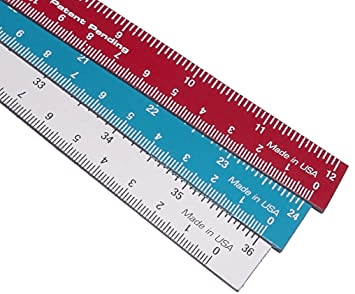
In a row of small lines following each other are millimeters. More precisely, the distance between these lines is one millimeter (1 mm):
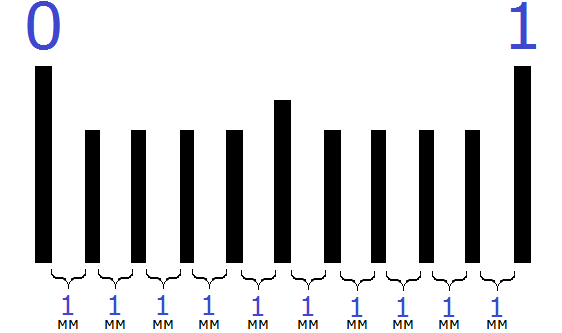
The next unit of measure is centimeters (cm). On a ruler, each centimeter is indicated by a number. For example, our ruler in the first picture was 15 centimeters long. The last centimeter on this ruler is marked with 15.
There are ten millimeters in one centimeter. One centimeter and ten millimeters can be equated because they represent the same length:
1 cm = 10 mm
You can see for yourself if you count the number of millimeters in the previous figure. You will find that the number of millimeters (distances between the lines) is 10.
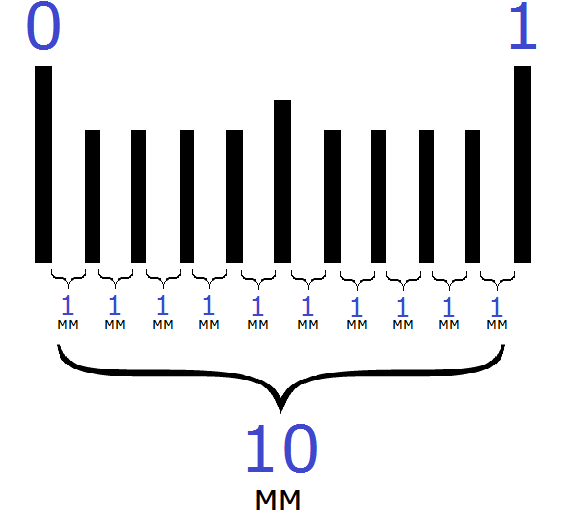
The next unit of length measurement is a decimeter (dm). There are ten centimeters in one decimeter. One decimeter and ten centimeters can be equated because they are the same length:
1 dm = 10 cm
You can see for yourself if you count the number of centimeters in the following picture:
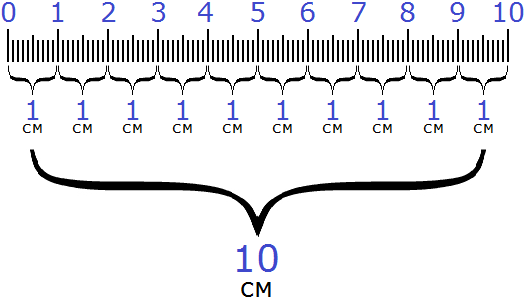
You will find that the number of centimeters is 10.
The next unit of measure is a meter (m). There are ten decimeters in one meter. One meter and ten decimeters can be equated because they are the same length:
1 m = 10 dm
Unfortunately, the meter cannot be illustrated in the picture because it is quite large. If you want to see the meter live, take a tape measure. Everyone has one in the house. On a tape measure, one meter will be marked as 100 cm. That's because one meter has ten decimeters and ten decimeters has a hundred centimeters:
1 m = 10 dm = 100 cm
100 is obtained by converting one meter into centimeters. This is a separate topic, which we will discuss later. For now, let's move on to the next unit of length measurement, which is called a kilometer.
Kilometer is considered the largest unit of length measurement. There are, of course, other older units, such as megameter, gigameter terameter, but we will not consider them, because for further study of mathematics the kilometer is enough for us.
There are a thousand meters in one kilometer. Between one kilometer and one thousand meters you can put an equal sign, because they denote the same length:
1 km = 1000 meters.
Distances between cities and countries are measured in kilometers. For example, the distance from New York to Washington DC is 328 km (straight line).
International System of Units SI
The International System of Units (SI) is a set of generally accepted physical quantities.
The main purpose of the international system of units SI is to reach agreements between countries in calculations.
We know that the languages and traditions of the countries of the world are different. There is nothing we can do about it. But the laws of mathematics and physics work the same everywhere. If in one country "two times two is four", then in another country "two times two is four".
The main problem was that for every physical quantity, there are several units of measurement. For example, we have now learned that there are millimeters, centimeters, decimeters, meters, and kilometers to measure length. If several scientists, speaking different languages, get together in one place to solve a problem, this large variety of units of length measurement can create contradictions between these scientists.
One scientist will say that in their country, length is measured in meters. A second may say that in their country length is measured in feet. A third might suggest his or her own unit of measurement.
That is why the international system of units SI was created. SI is an abbreviation of the French phrase Le Système International d’Unités, SI (which in English means the International System of Units SI).
The SI lists the most popular physical quantities and defines a common unit of measurement for each of them. For example, all countries have agreed that length will be measured in meters when solving problems. Therefore, when solving problems, if the length is given in another unit of measurement (for example, in kilometers), then it is necessary to translate it into meters. We will talk about how to convert one unit of measurement to another later. For now, let's draw our international system of SI units.
Our drawing will be a table of physical quantities. We will include each physical quantity we studied in our table and indicate the unit of measure that is accepted in all countries. We have now studied the units of length and learned that the SI system defines meters for measuring length. So our table will look like this:

Units of Measurement of Mass
Mass is the quantity of a substance in a body. Popularly, the mass of a body is called weight. Usually, when something is weighed, we say "it weighs so many kilograms", even though we are not talking about weight, but about the mass of the body.
However, mass and weight are different concepts. Weight is the force with which a body acts on a horizontal support. Weight is measured in newtons. And mass is a quantity that shows the amount of matter in that body.
But there is nothing wrong with calling body mass a weight. Even in medicine they say "human weight", even though they are talking about human mass. The main thing to be aware of is that these are different concepts.
The following units of measurement are used to measure mass:
- milligrams;
- grams;
- kilograms;
- hundredweights;
- tons.
The smallest unit of measurement is milligrams (mg). You will probably never use milligrams in practice. They are used by chemists and other scientists who work with small substances. It is enough for you to know that such a unit of mass measurement exists.
The next unit of measure is grams (g). It is customary to measure the amount of a product in grams when making a recipe.
One gram has one thousand milligrams. One gram and one thousand milligrams can be equated because they represent the same mass:
1 g = 1000 mg
The next unit of measure is the kilogram (kg). The kilogram is a common unit of measurement. Anything can be measured in it. The kilogram is included in the SI system. Let us also include another physical quantity in our SI table. It will be called "mass":

There are a thousand grams in one kilogram. One kilogram and one thousand grams can be equated because they represent the same mass:
1 kg = 1000 g
The next unit of measure is the hundredweight (centner). A hundredweight is a convenient way to measure the weight of a crop harvested from a small area or the weight of a load.
One hundredweight contains one hundred kilograms. One hundredweight and one hundred kilograms can be equated because they represent the same mass:
1 hw (ct) = 100 kg
The next unit of measure is the ton (t). Tons are usually used to measure large loads and masses of large bodies. For example, the mass of a spaceship or a car.
One ton has one thousand kilograms. One ton and one thousand kilograms can be equated because they represent the same mass:
1 t = 1000 kg
Units of Measurement of time
We don't need to explain what time is. Everyone knows what time is and why it is needed. If we open a discussion on what time is and try to define it, we will begin to delve into philosophy, and we do not need this right now. It is better to start with the units of measurement of time.
The following units of measurement are designed to measure time:
- seconds;
- minutes;
- hours;
- days
The smallest unit of measurement is the second (s). There are of course smaller units such as milliseconds, microseconds, nanoseconds, but we will not consider them, because it makes no sense at the moment.
Various indicators are measured in seconds. For example, how many seconds an athlete runs 100 meters. A second is included in the international system of SI units for measuring time and is designated as "s". Let us also include another physical quantity in our SI table. We will call it "time":
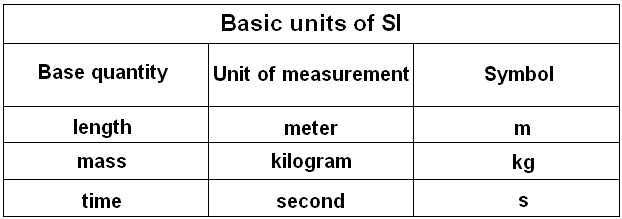
The next unit of time measurement is the minute (m). There are sixty seconds in one minute. One minute and sixty seconds can be equated because they represent the same time:
1 m = 60 s
The next unit of measure is the hour (h). There are sixty minutes in one hour. One hour and sixty minutes can be equated because they represent the same time:
1 h = 60 m
For example, if we studied this lesson for one hour and are asked how much time we spent studying it, we can answer in two ways: "we studied the lesson for one hour" or "we studied the lesson for sixty minutes". In both cases, we will answer correctly.
The next unit of time is a day. There are twenty-four hours in a twenty-four hour day. Between one twenty-four hours and twenty-four hours can be equated because they represent the same time:
1 day = 24 hours
Comments